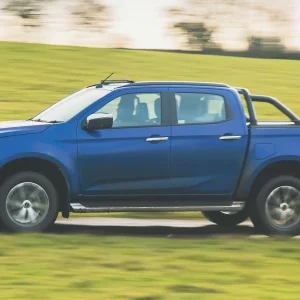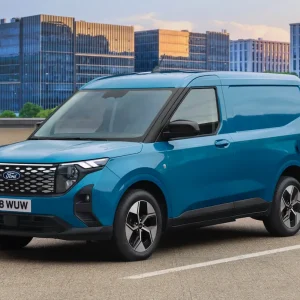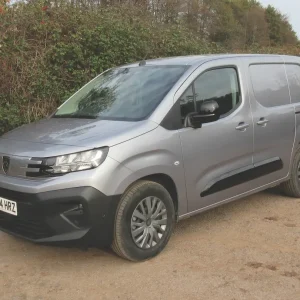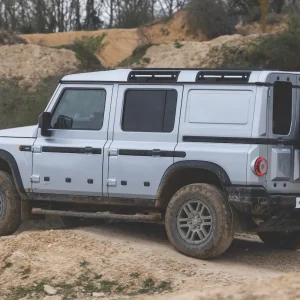Are we seeing a major swing away from diesel in favour of electric vans? Not yet – but with big fleets such as British Gas, Mitie and Sky all ordering battery-powered light commercials, the tipping point is now in sight.
British Gas alone announced an order for 2,000 Vauxhall Vivaro-e vans back in February after purchasing 1,000 last year. Vivaro-e shares the same basic design as Citroen’s e-Dispatch and Peugeot’s e-Expert. All three marques now form part of the recently created Stellantis along with Fiat Professional, and Toyota is marketing the same vehicle as the Proace Electric under a joint-venture agreement.
We opted to sample the e-Dispatch. Marketed with one height and the choice of three body lengths – 4.6m (XS), 4.95m (M) or 5.3m (XL) – it can be ordered with two different battery packs: 50kWh or 75kWh. The former has a claimed range of up to 148 miles on the Worldwide Harmonised Light Vehicle Test Procedure (WLTP) cycle, while the latter offers up to 211 miles.
Three different trim levels are available: X, Enterprise or top-of-the-range Driver.
Our three-seater demonstrator was a 4.95m M model built to Driver specifications with the 75kWh pack. All we needed to do was find the charging cable and plug the e-Dispatch in.

Load bay
Access to the 5.3m3 cargo area is by means of a sliding door on each side of the body and twin doors at the back. The rear doors can be pushed through 90º, or through 180º if you release the stays.
Six load tie-down points are provided and the full-height steel bulkhead features a flap at its base under the Moduwork banner, which allows extra-long items to be slid forwards into the cab. The outer passenger seat can be folded up to create extra carrying space.

Interior and equipment
Relying on battery power does not mean you have to put up with a meagre level of kit – far from it. Our test van boasted a reversing camera, reversing and front parking sensors, air conditioning and an electric handbrake, as well as cruise control with a variable speed limiter. Present too were a 12v power point – there is one in the load area as well – and a USB socket.
The socket is just one element of an infotainment package controlled by a 7in touchscreen. It includes Citroen Connect DAB radio, Bluetooth hands-free connectivity, Apple CarPlay, Android Auto and Citroen Connect satellite navigation with voice recognition.
It also comes with an annoying little coffee break icon, which pops up after two hours of continuous driving. Welcome to the nanny state.
Further features on this model include electric windows, as well as heated, folding exterior mirrors. The mirrors are electrically adjustable but lack a wide-angle section.
The touchscreen can display a schematic that shows how much charge is left in the battery pack. It also enables you to programme in the time you want charging to begin if your van is plugged in to a power socket.
In-cab storage facilities include a lidded but not lockable glove box with a shelf below it, and a big cubbyhole below that. In addition, there is a lidded compartment on top of the dashboard and good-sized cup/bottle holders at each extremity. You will find a shelf above the gear selector too.
Both the cab doors feature a large bin capable of accommodating a 1.5-litre bottle of water, with a small cubbyhole below it and another bin above it.
Both the driver’s seat and the steering column are height-adjustable, the seat comes with lumbar adjustment, and in theory it ought to be possible for most people to get comfortable. In practice, however, there is the offset driving position to contend with – and that cannot be classed as good news.
What’s more, whoever occupies the middle seat will find their right knee constantly pressed up against a moulding that bows outward from the fascia. Not exactly a recipe for a comfortable journey.
Pull down the centre section of the seat’s back and it turns into a desk with an elasticated band to keep paperwork in place. Pull up the cushion and you will find more than enough space to stash your smartphone.
Disc brakes are fitted all round, and the vast collection of on-board safety systems includes ABS, electronic stability control, hill start assist, electronic brakeforce distribution
and emergency brake assist.Lane departure warning, intelligent speed adaption and blind spot monitoring are installed as well.
Worthy of mention is the head-up display with traffic sign recognition: a chastening reminder of the speed limit you should be sticking to on the stretch of highway you are driving down.
As if all this wasn’t enough, you are also protected by advanced emergency braking system and forward collision warning.
Rain on the windscreen triggers the wipers and the van’s lights illuminate automatically at dusk. It’s also good to see front fog lights, complete with a cornering function.
Turning to the suspension, the e-Dispatch relies on MacPherson struts and an anti-roll bar at the front, with a trailing arm at the rear. Our test van’s fancy 17in alloy wheels, an added option for an extra £100, were shod with 215/60 R17C Michelin Agilis tyres – a good choice.
Electric power steering offers a 12.4m turning circle between kerbs, expanding to 12.9m between walls.

Powertrain
The lithium-ion battery pack powers
a 100kW (136hp) electric motor married to a single-speed gearbox. Maximum torque is 260Nm and is instantly available.
Lift your foot off the accelerator whenever you are descending a hill and the regeneration function pumps energy that would otherwise be lost into the battery. Every little bit helps, and the dashboard display tells you if your actions are boosting the battery’s charge level.
It also lets you know if you are driving economically or guzzling a lot of juice.
Driving
Perhaps surprisingly, the e-Dispatch comes with a conventional ignition key even though it doesn’t have a conventional ignition. You insert the key, then turn it until a sign on the dashboard display illuminates and tells you everything is ready.
Engaging D for drive couldn’t be easier. All you need to do is flick a switch between the driver’s seat and the adjacent passenger seat, and you are good to go.
Think carefully before you opt for an e-Dispatch if you spend a lot of your time on the motorway, though. When we took it down the M50 at a steady 65–70mph we saw the projected range rapidly drop, even though we were lightly laden.
To maintain our range we selected the van’s Economy setting whenever possible, which restricts motor power and torque. By doing so, you are draining less charge from the battery pack.
Although your motorway performance is reduced, the cut cannot be classed as dramatic unless you are tackling a lot of hills with a heavy load on board.
So far as we were concerned, given that the van was being driven in chilly weather, the reduction in output from the heater was more noticeable. The cab takes a while to warm up first thing anyway, so don’t forget your scarf and gloves on colder days. The Eco setting cuts the air-conditioning’s output as well.
Two other settings are available: Normal and Power. The latter gives you a lot more impetus if you are attempting to overtake slow-moving traffic – you feel a hefty shove between your shoulder blades as you accelerate – but range suffers accordingly.
Stick to Normal and you will find you have sufficient performance for most eventualities.
The van’s handling is surprisingly sharp, but the ride is rather lumpy if you are less than half-laden. The electric motor’s understated whine is less intrusive than the typical diesel engine rumble, but the lack of noise from beneath the bonnet means that the decibels generated by the tyres, the creaking of the suspension and the wind become far more noticeable.
There are no squeaks or rattles from the body, however; the build quality is good.
Pedestrians and cyclists will of course hear next to nothing from the van and may stray into its path as a consequence. To guard against this risk, the e-Dispatch is fitted with an acoustic vehicle alerting system.
It generates artificial sound when the vehicle is travelling at low speeds so that vulnerable road users know it is heading their way.

Operating
The dashboard display tells you how many miles you can travel before your battery is flat. Yet to overcome his acute range anxiety, the writer was happy to discover that regular round trips of 70–80 miles could be accomplished with ease, without the need to seek a public charging point, and with plenty of margin left for short local runs.
Emboldened, he tackled a 120-mile non-stop lightly laden round-trip – again in chilly temperatures – having completely recharged the battery pack, and made it back with 20 miles to spare. Not too bad a performance given that it was delivered in grim weather, but it did fall significantly short of the quoted range.
Relying on a 13A three-pin plug socket, domestic charging proved to be achingly slow, with an hour’s charging appearing to add no more than two or three miles to the e-Dispatch’s range.
Matters were not helped by the socket’s location on the end wall of a domestic garage. That involved the e-Dispatch being nosed in as far as possible, with the charging cable at maximum stretch.
In our view nobody should even think of opting for an electric van unless they at least have access to a sensibly positioned single-phase 32A 7.4kW wall box. That should allow you to charge from zero to 100% in just over 11 hours, Citroen claims.
A three-phase 16A 11kW wall box should get you from zero to 100% in seven hours, the manufacturer contends, while a DC 100kW fast charger should ensure you boost your battery from 15% to 80% capacity in 45 minutes.
The Mode 2 cable we were using is not a standard Citroen offering, and the manufacturer understandably does not encourage its use – although it should be stressed that this is because it makes charging painfully slow rather than unsafe. It advises owners to use the Mode 3 cable provided with the vehicle instead, which can be plugged into a wall box.
Fed by a 7kW on-board charger, the battery pack is covered by an eight-year/100,000-mile warranty triggered if the pack’s charging capacity falls below 70%. A three-year/100,000-mile warranty protects the rest of the vehicle.
The van qualifies for the maximum £6,000 government plug-in van grant, which reduces the basic price to £36,380 – still several thousand pounds more than the nearest equivalent diesel model.
It is important to point out, however, that the e-Dispatch does not qualify for vehicle excise duty and that employees who enjoy its private use have a 0% benefit-in-kind liability. Also note that you will not be charged if you enter a low-emission zone, given that the van does not produce exhaust emissions.
Service intervals are set at two years/25,000 miles. With no engine oil and filter changes, and no emission control system to worry about, the time spent in the workshop should be modest – along with the cost.
Metallic paint is standard on this model and our test van was finished in extra-dark chocolate metallic, described by Citroen as Perla Nera Black – an odd choice for a working vehicle. Everything is painted in the same colour including the door handles, mirror casings, bumpers and side rubbing strips.
Citroen e-Dispatch 75kWh M Auto Driver van
Price (ex VAT) £42,380**
Price range (ex VAT) £32,965-£42,380**
Gross payload 1,000kg
Load length 2,512mm
Load width (min/max) 1,258mm/1,628mm
Load bay height 1,397mm
Load volume 5.3m3
Loading height 544mm
Rear door aperture 1,282mm x 1,220mm
Side door aperture 935mm x 1,241mm
Gross vehicle weight 3,025kg
Braked trailer towing weight 1,000kg
Residual value 26.6%*
Cost per mile 47.7p
Engine size/power 100kW (136hp) electric motor
Torque 260Nm
Gearbox 1sp
Range 211mls (WLTP)
Battery 75kWh
Warranty 3yrs/100,000mls (battery 8yrs/100,000mls)
Service intervals 2yrs/25,000mls
Insurance group 36E
Price as tested £42,480**
* after 48 months/20,000mls p.a – source – KWIKcarcost
** Before plug-in van grant
Options
17in Curve bi-tone alloy wheels with Michelin Agilis tyres £100
Rivals
Mercedes-Benz e-Vito
Price (ex VAT) £40,895-£41,425**
Load volume 6.0-6.6m3
Gross payload 890-905kg
Electric motor 85kW
Verdict: Pleasant enough to drive, well built and with plenty of torque instantly available, the e-Vito suffers from a woefully low claimed range of just 92 miles between recharges. Nor is payload capacity particularly impressive for a van of its size. We cannot help but conclude that the e-Dispatch is a better bet.
Nissan e-NV200
Price (ex VAT) £26,250-£29,150**
Load volume 4.2m3
Gross payload 631-705kg
Electric motor 80kW
Verdict: When we road-tested this model back in 2019 we described it as the most convincing electric van we had encountered to date. New rivals have come along since, but with a decent-sized cargo area and a claimed range of up to 187 miles, the e-NV200 remains in contention. A special conversion is available with an 8.0m3 cargo area.
Renault Kangoo Van Z.E
Price (ex VAT) £26,000-£29,400**
Load volume 1.3-4.0m3
Gross payload 605-640kg
Electric motor 44kW
Verdict: An all-new Kangoo has just been announced, but it will not appear on this side of the Channel until next year, alas. A battery model will once again feature in the line-up with a beefier electric motor than the present Z.E, which remains available. Might be worth the wait, although prices have yet to be released.
The Final Verdict
Design 7/10 – Proof that a mid-size panel van can be a viable working tool for medium distances.
Cabin 6/10 – Plenty of storage space, but the offset driving position is a definite drawback.
Ride 6/10 – Progress can become lumpy and bumpy when the van is lightly laden.
Refinement 7/10 – Lack of engine sound highlights all the other sources of noise.
Load area 8/10 – Load-through ability is a plus point, longer items can easily be accommodated.
Handling/performance 7/10 – Both exemplary, but the more you exploit the latter, the faster the range goes down.
Engine/transmission 7/10 – The electric motor and single-speed transmission deliver all the torque you need.
Standard equipment 9/10 – You name it, e-Dispatch has probably got it; including metallic paint.
Operating costs 9/10 – Not cheap to acquire, but the PIVG reduces the price and it is cheap to run.
What Van? subjective rating 7/10 – Has its drawbacks, but shows the direction we’re all going to be heading in.
Overall Rating = 73/100





